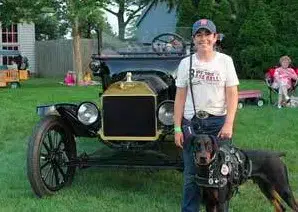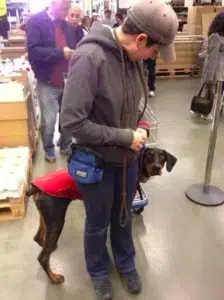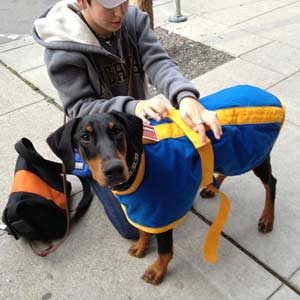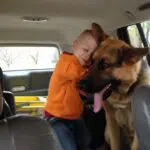Written by Colt Rosensweig
No one teaches their dog how to stand.
But dogs already know how to stand, you might say. Well, they know how to sit and lie down too, but we still teach them to do these things on cue, and stay until they are released. “Stand” is a cue that’s often ignored, both within and outside of the service dog community. For a service dog, I consider a solid “stand” an absolute must. For show dogs, obviously, it’s essential. And even for a pet dog, “stand” is one of the most useful things you can possibly teach your dog.
“Learning the stand teaches dogs to be comfortable, rather than nervous or scared, about being touched and handled all over their bodies.”
It can be surprisingly hard to teach a dog to stand and hold that position without moving around—especially if that dog has been taught from puppyhood that “sit” is the answer to almost every question. A lot of dogs, upon seeing a treat, will just sit automatically. (My affinity for “stand” is part of the reason I’m not much of a fan of the automatic sit.) It can be hard to find the right middle ground where the treat needs to be at the beginning of training—too low and the dog will usually lie down, too high and they’ll sit. With excited puppies, your fingers can take a beating, too, since it’s good to let them nibble for a long time at a large treat so they learn “stand” is something they need to hold, even when they’re being stroked.

When I first started teaching my now-retired service dog, Juno, to stand, she looked at me with a massively affronted expression of betrayal.
Why in the world was I touching her flank, her rear, her tail? Learning the stand teaches dogs to be comfortable, rather than nervous or scared, about being touched and handled all over their bodies. You can see where this would be essential for a service dog—especially for a dog that should not be sitting except when specifically told, like a guide or mobility dog. They have to be able to hold their position even when bumped, groped, or jostled. They also have to stand for a pat down sometimes when traveling by air. When I got Kaline as a puppy, “stand” was one of the first things I taught him.
This behavior is fantastic for pets as well.
Every dog, service dog or pet, has to visit the vet at some point, and usually one of the first things a vet will do is physically examine the dog. Vet visits are often stressful for dogs. If your dog has been taught to stand calmly while they’re examined, however, you can make your vet’s job significantly easier while simultaneously helping your dog feel more relaxed (or at least less stressed out) during their appointments.
It’s also helpful during grooming, whether your dog goes to a salon or you handle their grooming yourself.
During and after a bath, you have to be able to reach all parts of your dog, and a solid stand cue makes this so much easier. (I have an addiction to bathing my dogs with Chubbs bars … Trust me on this.) It’s easier to brush your dog out if they’ll hold a nice stand, and you can remove a lot of difficulty from your groomer’s job as well. And when dogs come in wet from a rainy walk, drying their bellies and paws is a breeze if they’ll stand for you.

For service dogs, “stand” is the foundation for tasks like “block/cover,” where a dog will stand in a certain place in relation to the handler to keep strangers out of the handler’s personal space, and counterbalance or bracing, where the dog’s ability to stand still is essential to his or her ability to help the handler rise from a seated position or the floor. It also comes in handy in bathrooms when you really don’t want your dog sitting or, gasp, lying down. And for pretty pictures when you’re out and about, of course!
Now go forth and teach all the dogs in your life to stand. You won’t regret it!









